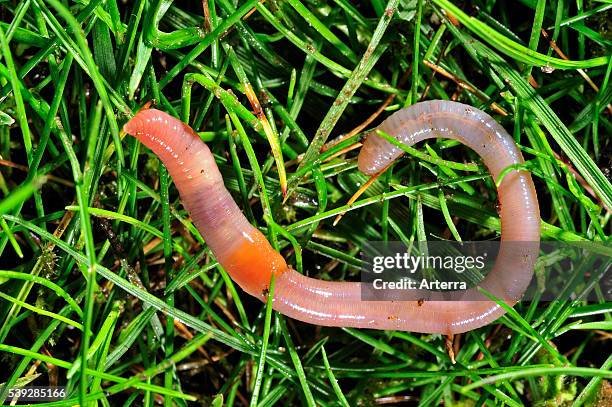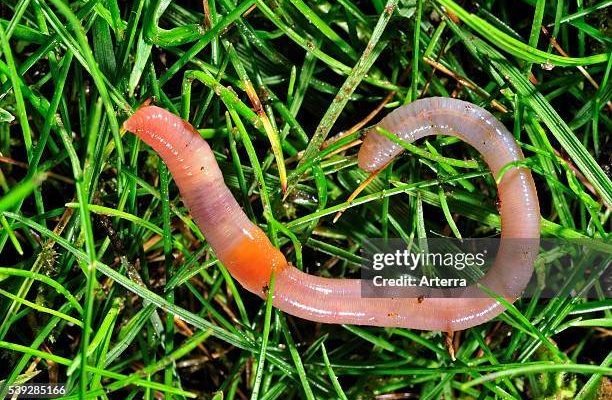
Imagine your garden’s soil as a bustling city. Earthworms are the diligent workers, moving through the ground, aerating it as they wiggle along. They help break down dead leaves and other organic materials, turning them into compost-like goodness. If you’re curious about the different types of earthworms you might encounter while digging in your garden, keep reading. We’ll explore some common species and how they contribute to a thriving ecosystem.
1. Nightcrawlers: The Garden Giants
One of the most recognizable types of earthworms is the nightcrawler. These earthworms can grow quite large, reaching lengths of up to 8 inches or more! They’re typically found in gardens, especially in the cooler months when they prefer to be active.
Nightcrawlers are fascinating because they burrow deep into the ground, creating channels that allow air and water to penetrate the soil. This helps improve drainage and encourages root growth for your plants. Honestly, if you’ve ever noticed your garden thriving after a rainstorm, you might have these guys to thank. They help mix surface materials with deeper soil layers, enriching the nutrients available to plants.
You might be wondering how to spot a nightcrawler in your garden. Look for their characteristic castings, which are small, shiny pellets filled with organic matter. If you find them, you’ve got a healthy soil ecosystem on your hands!
2. Red Wigglers: Composting Champs
If you’re into composting, you’ve probably heard of red wigglers. These small, reddish-brown earthworms are often used in compost bins because they thrive on decomposing organic material. Unlike nightcrawlers, red wigglers prefer to stay near the surface, munching on kitchen scraps and plant debris.
Red wigglers are fantastic recyclers. They consume waste and convert it into nutrient-rich compost, which is perfect for adding to your garden. Here’s the thing: if you want to create your own compost, adding red wigglers can boost the process significantly. They can eat up to half their body weight in organic material every day!
You can identify red wigglers by their segmented bodies and distinct reddish color. If you see them in your compost pile, pat yourself on the back—you’re doing great for your garden!
3. European Nightcrawlers: The Versatile Workers
European nightcrawlers, sometimes called Dendrobaena veneta, are another fantastic type of earthworm to find in your garden. These worms are slightly smaller than the common nightcrawler, typically growing to about 4-5 inches in length. They originated in Europe and have become popular among gardeners due to their adaptability and efficiency.
These worms are great for both soil aeration and composting. They can survive in various conditions and are often used in vermicomposting systems. By encouraging these worms in your garden, you’re not only enhancing soil structure but also speeding up the decomposition of organic matter, which translates into richer plants down the line.
If you’re lucky enough to have these worms, look for their castings, which are dark and crumbly—ideal for enriching your garden beds.
4. Brandling Worms: The Benthic Builders
Have you ever heard of brandling worms? These colorful little earthworms, often found in compost heaps and decaying organic matter, are known for their bold red and orange stripes. They thrive in moist environments and are commonly used in homemade compost systems.
Brandling worms help break down organic material quickly. They prefer a slightly warmer environment compared to other earthworms, which is why you’ll often find them near the surface, especially during the summer months. If you’re setting up a compost bin, adding some brandling worms can really kickstart the decomposition process.
Look for these worms when you’re turning your compost. Their presence means your pile is healthy and working efficiently!
5. Common Earthworms: The Soil Dwellers
The term common earthworm usually refers to a variety of species that are widespread in gardens around the world. These worms vary in size and color but generally share one thing in common: they’re exceptional at improving soil health.
Common earthworms travel through the soil, creating tunnels that aerate the ground, promoting water drainage and root growth. You might be surprised at how much they contribute to a vibrant garden ecosystem. They work tirelessly, munching on organic debris while their castings provide plants with necessary nutrients.
If you dig down a few inches in your garden and find these little guys, know you’re nurturing a productive environment. Their presence means your soil is alive with activity!
6. Why Earthworms Matter in Your Garden
Earthworms might seem small, but their impact on gardening is enormous. They improve soil structure, enhance nutrient availability, and help with water drainage. When you have a healthy population of earthworms in your garden, you’re giving your plants a better chance to thrive.
Here’s the thing: the more earthworms you have, the more alive your soil becomes. They break down organic matter into usable nutrients for plants, releasing essential minerals as they go. This means healthier plants, better harvests, and more beautiful blooms in your garden.
Plus, they help with pest control by promoting a balanced ecosystem. Plants with healthier root systems are less susceptible to diseases and pests, so it’s all connected!
7. How to Attract Earthworms to Your Garden
If you want to encourage these little garden workers, there are several simple things you can do. Here are some effective strategies to attract them:
- Add Organic Matter: Compost and mulch provide food sources for earthworms, making your garden irresistible.
- Avoid Chemicals: Pesticides and fertilizers can harm earthworm populations. Aim for organic gardening methods.
- Keep Soil Moist: Earthworms thrive in damp environments. Ensure your garden retains moisture.
- Provide Shelter: Leave some leaves or organic debris in your garden to offer a habitat for earthworms.
By creating a welcoming environment, you’ll not only attract earthworms but also promote a healthier garden ecosystem.
In conclusion, understanding the different types of earthworms commonly found in gardens opens up a world of possibilities for nurturing your outdoor space. Each worm species plays a unique role in enhancing soil health and supporting plant growth. Earthworms are essential partners in the garden, ensuring that your plants flourish. So next time you dig in the dirt, remember that those wriggly friends are working hard beneath the surface! Happy gardening!

